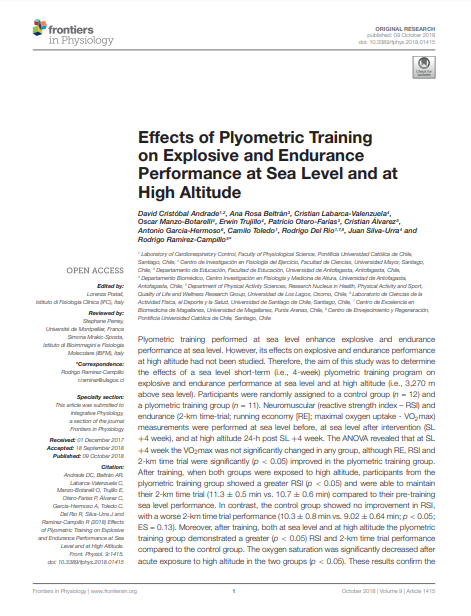Effects of Plyometric Training on Explosive and EnDuránce Performance at Sea Level and a High Altitude

Fecha
2018Autor
Cristobal Andrade, David [Univ Mayor, Fac Ciencias, Ctr Invest Fisiol Ejercicio, Santiago, Chile]
Rosa Beltrán, Ana
Labarca-Valenzuela, Cristián
Manzo-Botarelli, Oscar
Trujillo, Erwin
Otero-Farias, Patricio
Alvarez, Cristián
García-Hermoso, Antonio
Toledo, Camilo
Del Rio, Rodrigo
Silva-Urra, Juan
Ramírez-Campillo, Rodrigo
Ubicación geográfica
Notas
HERRAMIENTAS
Resumen
Plyometric training performed at sea level enhance explosive and enDuránce performance at sea level. However, its effects on explosive and enDuránce performance at high altitude had not been studied. Therefore, the aim of this study was to determine the effects of a sea level short-term (i.e., 4-week) plyometric training program on explosive and enDuránce performance at sea level and at high altitude (i.e., 3,270 m above sea level). Participants were randomly assigned to a control group (n = 12) and a plyometric training group (n = 11). Neuromuscular (reactive strength index - RSI) and enDuránce (2-km time-trial; running economy [RE]; maximal oxygen uptake - VO(2)max) measurements were performed at sea level before, at sea level after intervention (SL +4 week), and at high altitude 24-h post SL + 4 week. The ANOVA revealed that at SL + 4 week the VO(2)max was not significantly changed in any group, although RE, RSI and 2-km time trial were significantly (p < 0.05) improved in the plyometric training group. After training, when both groups were exposed to high altitude, participants from the plyometric training group showed a greater RSI (p < 0.05) and were able to maintain their 2-km time trial (11.3 +/- 0.5 min vs. 10.7 +/- 0.6 min) compared to their pre-training sea level performance. In contrast, the control group showed no improvement in RSI, with a worse 2-km time trial performance (10.3 +/- 0.8 min vs. 9.02 +/- 0.64 min; p < 0.05; ES = 0.13). Moreover, after training, both at sea level and at high altitude the plyometric training group demonstrated a greater (p < 0.05) RSI and 2-km time trial performance compared to the control group. The oxygen saturation was significantly decreased after acute exposure to high altitude in the two groups (p < 0.05). These results confirm the beneficial effects of sea level short-term plyometric training on explosive and enDuránce performance at sea level. Moreover, current results indicates that plyometric training may also be of value for enDuránce athletes performing after an acute exposure to high altitude.
Coleccion/es a la/s que pertenece:
Si usted es autor(a) de este documento y NO desea que su publicación tenga acceso público en este repositorio, por favor complete el formulario aquí.